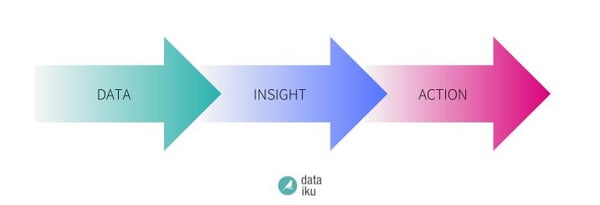The road from a pile of raw data to data-driven insights and from insights to action is paved with good intentions, but often learning things from data takes excessive time and energy. More often than not, businesses use all that energy going from data to insight, forgetting the last (and most important) part of the equation.

To that end, being data-driven isn’t the goal — it’s being insights-driven, and that’s also really where the challenge lies. And the core of the problem is the idea that your data should work for you, not the other way around. Often data is inaccessible or unstructured, making it impossible to learn anything from it. Outdated, messy, or disagreeing data sets can make team discussions inefficient.
When data is available, there’s often so much of it that decision-makers can’t know what to focus on, so they cherry pick the stats that most support what they already want to do. Oftentimes executives only rely on data when it supports their instincts, so in order to truly activate the data at your disposal, you need to ensure that your data makes the transition to insights. Data alone is not enough; you need to support high-quality data with transparent algorithms in order to help teams agree on what the data at their disposal means.
Beyond Being Data-Driven
In order to move beyond the isolated data-driven insights to become fully insights-driven as an organization, data needs to be accurate, accessible, and integrated:
Accurate data means that it updates automatically in real time. This way, your insights are not dependent on spreadsheets or slide decks that become outdated as soon as they’re completed.
Accessible data is shared between all stakeholders. When all users and stakeholders analyze the same central dataset, there are no disagreements on visibility, transparency, or access.
Integrated data usage only occurs when data analysis and exploration are incorporated into business and decision-making processes. The organizational changes surrounding data usage are often overlooked, but data leaders understand that serious commitment is required. Unless executives and data scientists alike implement the necessary process changes, organizations will never truly be data-driven.
Even data that is accurate, accessible, and integrated won’t solve all your analysis issues. With massive sets of information, it’s difficult to visualize even approximate trends, let alone extract meaning from them.
Becoming Insight-Driven
Again, getting from metrics to insights is the real challenge presented by overwhelming quantities of data. So even if data is in order as described above, that doesn’t mean insights will flow.
![]() There is no magic bullet beyond devoting the people resources, developing the right processes, and investing in the right technologies. For example, one factor that certainly helps move the needle from being data- to insights-driven is automation. When people spend less time on the mundane tasks of data preparation, they have more time to devote to things like astute model creation and developing valuable (perhaps predictive) insights that actually allow for action.
There is no magic bullet beyond devoting the people resources, developing the right processes, and investing in the right technologies. For example, one factor that certainly helps move the needle from being data- to insights-driven is automation. When people spend less time on the mundane tasks of data preparation, they have more time to devote to things like astute model creation and developing valuable (perhaps predictive) insights that actually allow for action.
If you’re interested in transforming your data-driven insights into concrete insights for the business, you’ll need to equip yourself with the tools for success — including alignment across people, processes, and technology.





